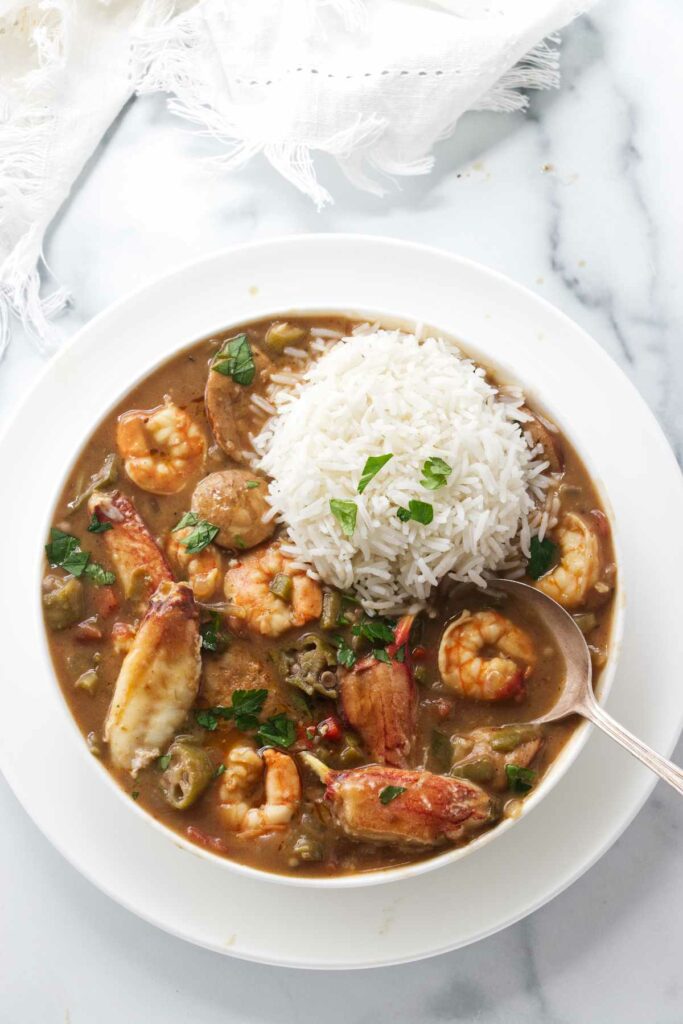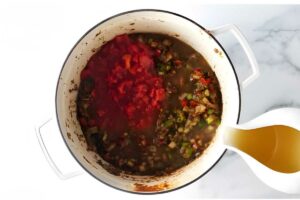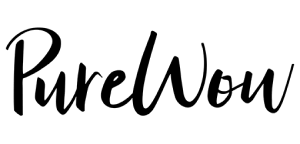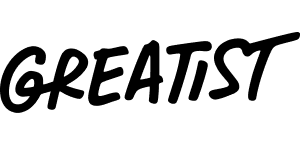This post may contain affiliate links. Please read our disclosure policy. As an Amazon Associate, I earn from qualifying purchases.
Diving into a rich, steaming bowl of Creole Seafood Gumbo is an unforgettable New Orleans experience that stays with you. This recipe stands out for its robust flavors, capturing the essence of the city’s culinary diversity.
I grew up watching my dad make gumbo, and this recipe carries some of those roots. It’s not just about the seafood or the spices; it’s about bringing together a melody of ingredients that echo the spirit of New Orleans in every bite.

If you’re craving more bold, coastal flavors after this seafood gumbo, our Brazilian fish stew is the next stop you’ll want to make.
Here’s Why This Gumbo Recipe Works
Deep, dark roux: Cooked low and slow until it’s the color of a milk chocolate bar. This classic Louisiana technique adds nutty, smoky depth you can’t fake.
Balanced aromatics: Onion, celery, bell pepper, garlic, and scallions build a sweet-savory base without overpowering the seafood.
Okra, the right way: Quick pan-frying keeps the okra tender but not slimy, with a slight caramelized edge
Seafood timing matters: Shrimp, crab, and calamari go in at the very end so this Gulf Coast gumbo stays tender and briny, never chewy.

Love gumbo in all its forms? Our Chicken and Sausage Gumbo takes the same slow-cooked roux and layers it with smoky sausage and tender chicken for a rich, comforting twist.

Recipe Tips
Toast the roux with patience: Stir constantly over low heat once it starts to brown. A dark roux takes time, but it’s where that deep, smoky gumbo flavor begins.
Prep in stages: Make the base up to 3 days ahead to save time and deepen the flavor. It gives you a head start on both cooking and cleanup.
Add the seafood last: Shrimp, crab, and any other seafood cook fast, just a few minutes in hot broth. Add them at the end so they stay tender, not tough.
Control the heat: Start light with the Creole seasoning, then taste and build until it’s just spicy enough for you. You can always add more, but you can’t take it out.
Pass the filé at the table: Sprinkle filé powder after cooking, not before. It adds that earthy, herbal note classic to Louisiana gumbo and thickens slightly as it cools.
Use a wide, heavy pot: A Dutch oven or heavy-bottomed pot gives you even heat for browning the roux and prevents scorching.
Let it rest before serving: After the final simmer, let the gumbo sit for 10–15 minutes. The flavors settle and the broth thickens slightly for a richer finish.
Serve with fresh rice: Gumbo is meant to be ladled over fluffy white rice. Use long-grain white rice or jasmine for the best texture and balance.

Ingredient Highlights
Roux: The backbone of any good gumbo. Cook it low and slow until it’s dark brown. A dark roux builds that deep, smoky flavor and rich color that define Louisiana gumbo.
Andouille sausage: Adds spice, smokiness, and body to the gumbo. If you can’t find authentic Cajun andouille, use a good smoked sausage with a little heat.
Seafood: A mix of shrimp, crab, and (optional) calamari brings a briny sweetness that balances the roux. Add the seafood at the end so it stays tender.
Okra: Adds subtle flavor and just enough natural thickening. Pan-frying it first keeps the texture tender and prevents a slimy texture.
The Holy Trinity: Onion, celery, and bell pepper form the classic Creole base. They add depth and a natural sweetness that builds flavor.
Creole seasoning: A blend of paprika, cayenne, thyme, and garlic powder. Start light, then taste and adjust for your preferred spice level.
Filé powder: Made from ground sassafras leaves, filé adds an earthy, herbal note that’s distinctively Louisiana. It’s optional but traditional. Sprinkle it at the table.
Stock: Seafood stock adds the most flavor, but chicken stock works well too. For extra depth, add a splash of clam juice or a spoonful of shrimp paste.

Seafood Gumbo
This seafood gumbo doesn’t mess around. It’s smoky, spicy, and brimming with shrimp, sausage, and rich Southern flavor. Start with a slow roux, layer in your base, and finish with just-cooked seafood for a gumbo that tastes like it came straight from a Louisiana kitchen.
Craving more Creole comfort food? Try our Creole Jambalaya Recipe. It’s a classic with shrimp, sausage, and that same balance of smoky spice you’ll find in this gumbo.
Pin this now to find it later!
Pin It
Creole Seafood Gumbo
If you make this recipe, please leave a star rating and comment.
Ingredients
- 16 ounces okra, sliced; fresh or frozen (defrosted)
For the Roux
- ½ cup vegetable oil
- ½ cup butter, or bacon drippings
- 1 cup all-purpose flour
For the Base Gumbo Recipe
- 1 large onion, chopped
- 1 bunch scallions, chopped
- 2 bell peppers, chopped; I used red and green peppers
- 4 stalks celery , chopped
- 6 garlic cloves, grated or minced
- 1 (14 ounce) can canned diced tomatoes
- 4 cups chicken broth
- 2 cups fish broth , seafood stock or clam juice
- 1 cup dry white wine
- 3 bay leaves
- 1 teaspoon dried thyme
- 1 to 2 sprigs Fresh thyme
- 1 teaspoon Creole seasoning, or to taste
- 1 pound Andouille sausage, sliced
For the Seafood
- 2 pounds large shrimp, de-headed, peeled and veins removed
- 1 pound crab meat, picked over
- 12 shucked oysters, (optional)
- 1 pound frozen calamari rings, thawed (or firm fish, See Notes)
- ⅓ cup fresh chopped parsley
- Filé powder, (Optional, See Notes)
Instructions
Cook the okra:
- Heat the oil in a skillet set over medium-high heat, add the defrosted cut okra and cook, stirring often until the ropy liquid begins to subside, and the okra begins to brown, about 5-8 minutes. Transfer the okra to a plate and reserve.

Make the roux:
- Add the olive oil and the bacon drippings or butter to a 6-qt. Dutch oven or large soup pot set over medium-high heat. Add the flour and stir continually until the mixture turns golden.

- Reduce the heat to low and continue to cook and stir frequently until the roux browns to the color desired. I like to shoot for a dark brown (the color of a chocolate bar). This process can take 35 to 60 minutes depending on how dark you make the roux. A darker roux will give you a more robust flavored gumbo but don't let it turn black or it will become bitter. If you want a really thick gumbo, cook the roux for only 2 to 5 minutes (it won't have as much flavor but it will have more thickening power).

Prepare the Gumbo Base:
- Add the onions, scallions, green and red bell pepper, and the celery to the pot. Cook, stirring frequently until soft, about 3-5 minutes. Add the garlic and cook until fragrant, about 30-seconds.
- Add the tomatoes, fish broth, chicken broth, wine, bay leaves, thyme, and Creole seasoning. Bring to a simmer and cook for 15 to 20 minutes.

- Add the andouille sausage and the reserved cooked okra and continue simmering for another 15 minutes. Taste the broth and adjust the seasoning if necessary. If desired, you can make this portion of the gumbo 3 days in advance and keep stored in the fridge before adding the seafood.

Add the Seafood
- When ready to serve, bring the pot to a boil then reduce the heat to a gentle simmer.
- Add the shrimp, cover the pot and simmer for 2 more minutes. Add the crab meat, oysters (if using) and calamari rings. Simmer for 2 more minutes then remove from the heat.

- Stir in the chopped green scallions and all but 2 tablespoons of the parsley for garnish. Serve immediately in bowls with rice and garnish each serving with parsley. Offer a shaker of filé to be sprinkled on each serving as desired.
Notes
Nutrition
Nutrition information is automatically calculated, so should only be used as an approximation.
 Like this recipe? Rate & comment below!
Like this recipe? Rate & comment below!















I just love that you’re calling it Creole, not Cajun like I have my whole life until I learned better the other day
Thanks,Grace….I hope you also love this delicious gumbo! ❤️ ?
Good tip to remove the seafood from the gumbo if freezing — and then reheat the gumbo base before adding the seafood. Overcooked seafood is no fun. Anyway, I was thinking about gumbo last night! This looks wonderful — thanks.
Thanks, John…this is really delicious! You should check out our other post, Gumbo, as well. It has a lot of goodies in it too. ?